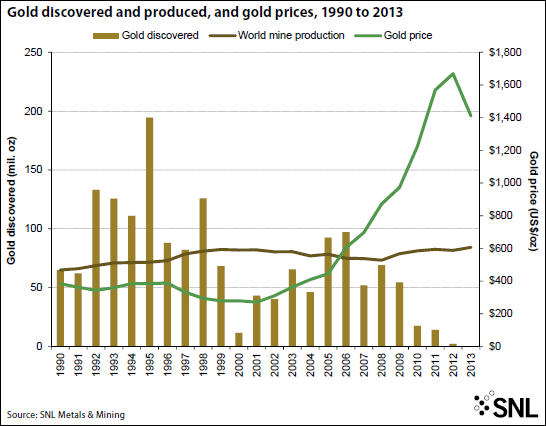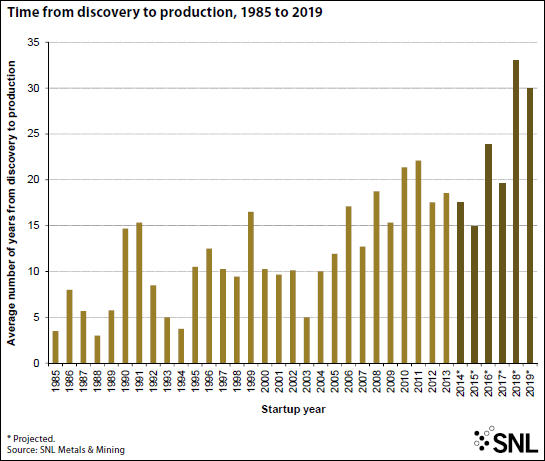by Frik Els
Where will we find the gold?
The CEO of the world's most valuable gold miner Goldcorp (TSE:G) says "peak gold" will be reached this year or in 2015.
Chuck Jeannes told the Wall Street Journal global gold production will start to decline "as easy-to-mine gold deposits become harder to find" and in the absence of any major technological breakthrough:
"Whether it is this year or next year, I don't think we will ever see the gold production reach these levels again," he said. "There are just not that many new mines being found and developed."
Jeannes says a drop in mine supply from a high of 2,270 tonnes in 2013 will support the gold price and lead to further consolidation in the industry as gold majors opt to buy ounces.
Last year Goldcorp, worth $22.3 billion on the Toronto Stock Exchange, made an unsuccessful bid for fellow Canadian miner Osisko, but Jeannes could not be drawn on whether the Vancouver-based company plans to launch any other bids in the short term.
Goldcorp said last week its 2014 output could end up near the bottom end of its forecast range of 2.95 – 3.1 million ounces because of production problems at a Mexico mine.
Over the past 24 years, mining companies discovered 1.66 billion ounces of gold in 217 major gold discoveries, according to a recent study by SNL Metals & Mining, a resources research house.
The amount of gold discovered and the number of major discoveries (defined as any deposit with a minimum of 2 million ounces of contained gold) have been trending downward over time, from 1.1 billion ounces in 124 deposits discovered during the 1990s to only 605 million ounces in 93 deposits discovered since 2000.
Only seven gold deposits holding more than 2 million ounces have been discovered this decade vs 22 in 1995 alone
The amount of potential production from these major discoveries is particularly concerning when looking at the discoveries made in the past 15 years. Assuming a 75% rate for converting resources to economic reserves and a 90% recovery rate during ore processing, the 674 million ounces of gold discovered since 1999 could eventually replace just 50% of the gold produced during the same period the Strategies for Gold Reserves Replacement study found.
Considering that only a third of the discovered gold has been upgraded to reserves or has already been produced, and that many of these deposits face significant political, environmental or economic hurdles, the amount of gold becoming available for production in the near term is certainly much less, the report adds.

The time it takes to bring a deposit into production is also increasing significantly, slowing the rate at which production is replaced. Between 1985 and 1995, 27 mines with confirmed discovery dates began production an average of eight years from the time of discovery. The time from discovery to production increased to 11 years for 57 new mines between 1996 and 2005, and to 18 years for 111 new mines between 2006 and 2013.

The length of time from discovery to production is expected to continue trending higher: 63 projects now in the pipeline and scheduled to begin production between 2014 and 2019 are expected to take a weighted-average 19.5 years from the date of discovery to first production.
No comments:
Post a Comment